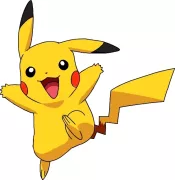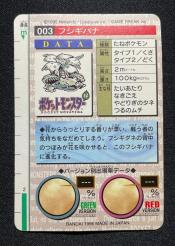

Pokémon are fictional creatures that inhabit a fictional world where they co-exist with humans. There are a large variety of these species endowed with special powers. Pokémon is a shortened version of their original name Pocket Monsters. Pokémon have been around since 1996 and the franchise now consists of video games, books, television series and films, trading cards, countless pieces of merchandise, and various other products.
The most notable Pokémon is a small electric type creature named Pikachu. However, there are over 1,000 Pokémon from various regions of the Pokémon world. Each of these creatures has a type, which determine certain features and the appearance of each creature. There are 18 different types of Pokémon: bug, dark, dragon, electric, fairy, fighting, fire, flying, ghost, grass, ground, ice, normal, poison, psychic, rock, steel, and water.
These are some of the basics of Pokémon. For more detailed information check out the below tabs.
- History
- Image

The first Pokémon game came out on February 7, 1996 in Japan.
Nintendo was a bit unsure about Pocket Monsters at first, but eventually accepted, and Satoshi Tajiri (the creator of Pokémon) spent the next six years working with legendary game maker Shigeru Miyamoto (the man behind Mario and The Legend of Zelda) to make Pocket Monsters a reality.
On Feb. 27, 1996, Pocket Monsters was released in a Red and Green version for the Gameboy, in Japan. The games were on a cartridge, and players could trade Pokémon using a cable to connect to each other's Gameboy. The games went on to sell millions of copies, and were later released to the US in 1998, and the UK a year later, as a Red and Blue version (instead of Green). The name was also shortened from Pocket Monsters to Pokémon.
Image
Since then, seven more generations of Pokémon games have been released, from Gold and Silver, to Ruby and Sapphire, Diamond and Pearl, Black and White, X and Y, Sun and Moon, Sword and Shield, and most recently Scarlet and Violet. With each new generation more Pokémon joined the games.
After the success of the first games, a company called Media Factory created the Pokémon Trading Card Game (or TCG for short). The first set of cards was released on October 20, 1996, containing 102 cards, with drawings by Ken Sugimori, Mitsuhiro Arita and Keiji Kinebuchi. The cards soon became very popular, and three years later in 1999, they were introduced to North America by Wizards of the Coast and shortly after the rest of the world. Pokémon card tournaments sprang up, where players could battle it out, and there is now even a world championship tournament. Since then, more than 30 billion cards have been printed, and some people will even pay hundreds of thousands of pounds for some of the more rare cards.
- Upcoming Library Events
- Image

Until Saturday, August 2 @ Library Partnership Branch
Every week this summer a different Pokémon was be hidden in the Library Partnership Branch. For every Pokémon you can find, you get a badge. Come back each week to earn different badges. Get all 8 badges for a special prize!
Pokémon Party - Gotta Catch 'Em All!
Wednesday, July 9, 3 p.m. @ Tower Road Branch
This Summer we will be celebrating all things Pokémon with art, activities, games, and a vote for our favorite Pokémon generation. No registration required.
Fandomonium
Saturday, September 27, 10 a.m. to 4 p.m. @ the Headquarters Library
Fandomonium is back! Join us at the Headquarters Library for the return of this free, all-ages fan convention. Come dressed as your favorite character and enter our cosplay contest. Rally your best and brightest to compete as a team at fandom trivia. Wander through an artist alley and peruse goods from local vendors. Into Pokémon? We'll have a Pokémon specific craft and other fun surprises. We’ll have special guest speakers, panels, games, and more!
Check out some of the many Pokémon books, movies, and television shows we have available for check out at the library.
Information gathered from various sources, including: Pokémon Wiki, Pokémon.com, and Game Press.